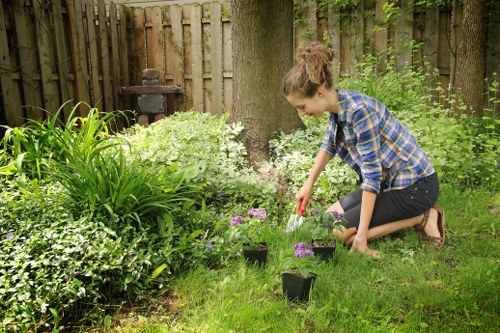Hedge Trimming in Poplar: Best Practices for a Lush Landscape

Maintaining a beautiful and healthy landscape often relies on the art of hedge trimming, especially when it comes to poplar trees. Hedge trimming in poplar not only enhances the aesthetic appeal of your garden but also promotes the overall health and growth of the trees. Whether you are a seasoned gardener or a DIY enthusiast, understanding the nuances of trimming poplar hedges can make a significant difference in achieving a lush and vibrant outdoor space.
Poplar trees are a popular choice for hedging due to their rapid growth and dense foliage. However, their fast growth rate can lead to overgrown hedges that require regular maintenance. Proper trimming ensures that the hedges remain shapely, healthy, and free from pests and diseases. In this article, we will delve into the best practices for hedge trimming in poplar, providing you with the knowledge needed to maintain your poplar hedges effectively.
Before you embark on trimming your poplar hedges, it's essential to understand the characteristics of poplar trees and the benefits they offer. This foundation will help you make informed decisions about how and when to trim your hedges to achieve the best results.

Understanding Poplar Hedging
Poplar trees are known for their tall stature, fast growth, and vibrant green leaves. They belong to the genus Populus and are native to the Northern Hemisphere. Poplars are often used in landscaping for their ability to create quick privacy screens and windbreaks. Their rapid growth rate makes them an excellent choice for establishing hedges in a shorter period compared to other tree species.
One of the key characteristics of poplar trees is their ability to adapt to various soil types and climatic conditions. This adaptability makes them a versatile choice for hedging in different regions. However, their fast growth also means that without regular maintenance, poplar hedges can become unruly and difficult to manage.
Understanding the growth patterns and care requirements of poplar trees is crucial for effective hedge trimming. Proper trimming not only maintains the desired shape but also encourages healthy growth and prevents potential structural issues.

Characteristics of Poplar Trees
Poplar trees are distinguished by their lightweight wood, broad leaves, and rapid growth rate. They can grow up to 60 feet tall, making them a prominent feature in any landscape. Their leaves are usually large and triangular, providing ample shade and a lush appearance throughout the growing season.
Their roots are extensive and can spread widely, which is something to consider when planting poplar hedges near structures or other plants. Despite their beauty and utility, poplars are susceptible to certain pests and diseases, which can be mitigated through proper trimming and maintenance practices.
Regular monitoring and trimming can help keep poplar hedges healthy and prevent issues such as branch breakage, overcrowding, and disease spread. By understanding these characteristics, you can better manage your poplar hedges to enhance both their functionality and appearance.
Benefits of Using Poplar for Hedges
Using poplar trees for hedges offers several benefits:
- Rapid Growth: Poplars grow quickly, allowing you to establish dense hedges in a relatively short time.
- Privacy: Their thick foliage provides effective privacy screens, blocking views from neighbors and passersby.
- Windbreak: Poplar hedges act as excellent windbreaks, protecting your property and garden from strong winds.
- Aesthetic Appeal: The lush, green appearance of poplar hedges adds beauty and greenery to any landscape.
- Low Maintenance: With regular trimming, poplar hedges are relatively easy to maintain.

When and How to Trim Poplar Hedges
Timing is crucial when it comes to hedge trimming in poplar. Proper timing ensures that the trees respond well to pruning, promoting healthy growth and maintaining the desired shape. Additionally, understanding the correct trimming techniques and using the right tools are essential for effective hedge maintenance.
Poplar hedges should generally be trimmed during the late winter or early spring before new growth begins. This timing allows the trees to recover quickly and produce robust new shoots. Avoid trimming during the peak growing season, as this can stress the trees and make them more susceptible to pests and diseases.
When trimming poplar hedges, it's important to follow a systematic approach. Start by removing any dead or diseased branches, then shape the hedge to the desired form. Ensure that the cuts are clean and made at the right angle to promote optimal healing.

Ideal Time for Hedge Trimming
The best time for hedge trimming in poplar is during the dormant season, typically late winter or early spring. Trimming at this time minimizes stress on the trees and encourages vigorous growth in the spring. Avoid trimming late in the growing season, as this can interfere with the tree's ability to harden off before winter.
Additionally, consider the local climate and weather conditions when planning your hedge trimming schedule. In regions with harsh winters, it's best to complete trimming well before the first frost to allow the trees ample time to recover.
Regular annual trimming during the appropriate season will keep your poplar hedges healthy, dense, and visually appealing. Establishing a consistent trimming routine ensures that the hedges remain in top condition year-round.
Tools Needed for Trimming Poplar
Having the right tools is essential for effective hedge trimming in poplar. Using proper equipment not only makes the task easier but also ensures clean cuts that promote healthy growth. Here are some essential tools you'll need:
- Pruning Shears: Ideal for trimming small branches and shaping the hedge.
- Electric or Manual Hedge Trimmers: Useful for cutting large sections quickly and achieving an even surface.
- Loppers: Necessary for removing thicker branches that are beyond the capacity of pruning shears.
- Gloves: Protect your hands from thorns, rough branches, and debris.
- Safety Goggles: Shield your eyes from flying debris during trimming.
Step-by-Step Trimming Process
Trimming your poplar hedges involves several steps to ensure a clean and effective result:
- Inspect the Hedge: Begin by examining the entire hedge for any dead, diseased, or damaged branches. Remove these first to prevent further issues.
- Clean Up: Remove any litter, fallen leaves, or debris from around the base of the hedge to maintain a tidy appearance.
- Shaping: Decide on the desired shape of your hedge—be it flat, rounded, or formal. Use hedge trimmers to achieve a uniform shape.
- Prune Strategically: Trim the sides of the hedge first, ensuring evenness. Then, move to the top to maintain the overall height and shape.
- Step Back and Assess: Periodically step back to assess the balance and symmetry of the hedge, making adjustments as needed.
- Final Touches: After the main trimming, use pruning shears for any detailed shaping or to clean up uneven areas.
By following this systematic approach, you'll ensure that your poplar hedges remain healthy, well-shaped, and visually appealing.

Maintenance Tips for Healthy Poplar Hedges
Maintaining healthy poplar hedges goes beyond regular trimming. Implementing proper maintenance practices ensures that your hedges remain robust and free from common issues such as diseases and pest infestations.
Here are some essential maintenance tips for your poplar hedges:
Regular Trimming Schedules
Establishing a consistent trimming schedule is key to preventing overgrowth and maintaining the desired shape of your hedges. Depending on the growth rate and your aesthetic preferences, poplar hedges may require trimming once or twice a year.
Regular trimming not only keeps the hedges looking neat but also encourages dense growth by preventing the spreading of branches. This density is crucial for achieving effective privacy screens and windbreaks.
Disease and Pest Management
Poplar hedges can be susceptible to various pests and diseases, including aphids, caterpillars, and fungal infections. Regular inspection of your hedges can help identify and address these issues early.
Implement integrated pest management (IPM) strategies, such as introducing beneficial insects, using organic pesticides, and maintaining good hygiene around the hedges. Additionally, ensuring proper air circulation through adequate trimming can reduce the risk of fungal diseases.

Common Mistakes to Avoid in Hedge Trimming
Avoiding common mistakes in hedge trimming in poplar is essential for maintaining healthy and attractive hedges. Here are some pitfalls to watch out for:
Over-Trimming or Under-Trimming
Over-trimming can stress the trees, leading to reduced growth and increased vulnerability to pests. On the other hand, under-trimming results in overgrown hedges that are difficult to manage and may not provide the desired privacy or aesthetic appeal.
Finding the right balance is crucial. Follow a regular trimming schedule and avoid removing more than one-third of the hedge's density at a time to prevent undue stress on the trees.
Incorrect Tool Usage
Using the wrong tools or improper techniques can damage the branches and leaves of your poplar hedges. Ensure that your pruning tools are sharp and clean to make precise cuts.
Always trim at the correct angle and avoid leaving stubby branches, which can become entry points for pests and diseases. Proper tool maintenance and usage techniques are vital for effective and safe trimming.

Professional vs. DIY Hedge Trimming
Deciding between hiring professionals or undertaking hedge trimming in poplar yourself depends on various factors, including your budget, time, and expertise. Both approaches have their advantages and considerations.
Benefits of Hiring Professionals
Professional hedge trimmers offer expertise and efficiency that can be invaluable, especially for large or complex hedges. They have the necessary tools and knowledge to perform the job correctly, ensuring that your poplar hedges are well-maintained and healthy.
Hiring professionals can save you time and reduce the physical strain associated with trimming large hedges. Additionally, they can provide insights and recommendations for ongoing maintenance to keep your hedges in optimal condition.
Tips for DIY Enthusiasts
If you prefer a hands-on approach, DIY hedge trimming can be a rewarding experience. Here are some tips to help you succeed:
- Educate Yourself: Learn about the specific needs and growth patterns of poplar trees.
- Invest in Quality Tools: Use sharp, reliable tools to make clean and precise cuts.
- Plan Your Trimming: Develop a trimming schedule and stick to it for consistent maintenance.
- Take Safety Precautions: Wear appropriate protective gear and be mindful of your surroundings.
With the right preparation and care, DIY hedge trimming can maintain your poplar hedges effectively and affordably.

Enhancing Your Landscape with Well-Maintained Poplar Hedges
Well-maintained poplar hedges can significantly enhance the overall look and functionality of your landscape. Beyond their aesthetic appeal, poplar hedges provide practical benefits that contribute to a comfortable and secure outdoor environment.
Aesthetic Benefits
Poplar hedges add a lush, green backdrop to your garden, creating a serene and inviting atmosphere. Their dense foliage and uniform shape can be tailored to complement various landscaping styles, from formal gardens to naturalistic settings.
By carefully trimming your poplar hedges, you can create visually appealing patterns and shapes that enhance the beauty of your property. Seasonal trimming can also introduce variety and keep your landscape looking fresh throughout the year.
Privacy and Windbreak Advantages
One of the primary functions of poplar hedges is to provide privacy. Their height and density effectively block unwanted views, creating a secluded space for relaxation and outdoor activities.
Additionally, poplar hedges act as excellent windbreaks, protecting your garden and property from strong winds. This can help reduce soil erosion, protect other plants, and create a more comfortable microclimate in your outdoor space.
Environmental Benefits
Poplar hedges contribute to the environment by improving air quality, providing habitat for wildlife, and acting as carbon sinks. Properly maintained hedges can support diverse ecosystems, attracting birds and beneficial insects.
Moreover, by reducing wind speed and preventing soil erosion, poplar hedges play a role in sustaining the health of your garden and surrounding areas. Incorporating eco-friendly practices in your hedge maintenance can further enhance these environmental benefits.
Final Touches and Personalization
Personalizing your poplar hedges with flowers, climbers, or integrated lighting can add unique touches to your landscape. These enhancements not only increase the visual appeal but also add functionality and character to your outdoor space.
Experimenting with different trimming styles and incorporating decorative elements can make your poplar hedges a standout feature of your garden, reflecting your personal style and preferences.

Conclusion
Effective hedge trimming in poplar is essential for maintaining healthy, attractive, and functional hedges. By understanding the characteristics of poplar trees, timing your trimming appropriately, using the right tools, and following best practices, you can ensure that your poplar hedges enhance your landscape for years to come.
Whether you choose to tackle the task yourself or hire professional services, the key is consistent and informed maintenance. Well-trimmed poplar hedges not only boost the beauty of your garden but also provide practical benefits such as privacy, wind protection, and environmental support.
Don’t wait to transform your landscape—Contact us today to learn more about our hedge trimming services and keep your poplar hedges in perfect shape. Book your service now and enjoy a lush, well-manicured garden that stands out in your neighborhood.